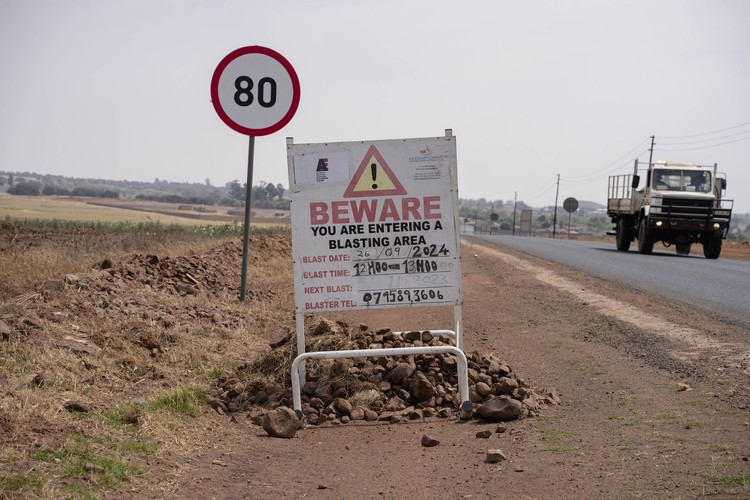New blasting limits set for mines - at last
Chief Inspector of Mines publishes South Africa’s first mine blasting standards
The Department of Minerals and Energy has released new limits which mines must follow before blasting. Archive photo: Ihsaan Haffejee
After years of pressure from communities affected by blasting the Department of Mineral Resources and Energy has released new legal requirements for mines.
Thousands of people across the country have been living in danger from blasting for years. Homes and fields have been left cracked and irreparably damaged from blasting impacts. Many people have been traumatised by continued ground and air shock waves generated by blasts.
Children are especially affected.
A teacher from a primary school located close to a mine in the coal-rich Newcastle region of KwaZulu-Natal told the Centre for Environmental Rights: “When they blast we can see the little ones running out of the classrooms from the fright, screaming and crying. Why don’t they warn the teachers about the blast, then the children can be prepared? It would be so easy to do. A whole generation is being traumatised unnecessarily here.”
In August 2024, the Chief Inspector of Mines, David Msiza published new standards for mine blasting operations. These standards will be effective from 1 November 2024, giving mining companies three months to prepare.
Officially referred to as a “Guideline for a Mandatory Code of Practice for Minimum Standards on Ground Vibrations, Noise, Air-blast and Flyrock near Surface Structures and Communities to be Protected” these new legal requirements are a step forward for communities who for decades have suffered damage to property and serious violations of their rights due to mine blasting.
Before these minimum standards, the Department of Mineral Resources and Energy used American blasting limits known as the USBM to guide “acceptable” levels for ground and air vibration shockwaves in South Africa. South Africa’s new minimum standards follow the USBM recommended levels. The standards take into account that houses of different strengths can withstand different blasting, and the ground vibration limits are lower for mud houses than for formal housing.
While the USMB standards were previously used as a guide, the newly published limits provide concrete, set levels over which mines may not blast. For instance, a mine’s blasting operations may no longer exceed the limit of 134 decibels for air vibration shockwaves outside a mining area.
Ten things to know about the new standards:
- All mines which blast must prepare a “Code of Practice” (COP) document which must comply with these new blast standards. This must be easily available to anyone affected by the mine’s blasting operations.
- The COP must describe how mines manage risks and hazards from blasting operations, including managing noise, flyrock, ground and air shockwaves.
- The COP must show how mines have tried to eliminate, control, minimise, and, importantly, monitor the risk posed by blasting operations.
- The COP must include the results of a risk assessment of any structures (including homes) potentially impacted by blasting.
- The COP must set limits for ground and air shockwaves based on the mine’s surroundings. For instance, if there are informal or mud houses close by, the blasting levels will be set lower than if there are no houses. Different blasting levels are set for national roads, electricity lines, railways, wells and houses of different construction.
- The COP must determine how often follow-up surveys of structures impacted by blasting must be conducted. This means that the mine must return to houses after blasting operations and check on the impacts.
- When there is significant risk to communities from blasting, the mine must put together a team which includes experts and community representatives. Together, this team must create a programme to limit blasting impacts, and blasting levels must comply with the new standards.
- Mines must monitor every blast and record levels of noise, ground and air vibrations and flyrock.
- Mines must manage blasting complaints and increase community awareness through posters and consultations.
- Surrounding communities must be warned of every planned blasting activity. Warning can be given through posters, alarms, notice boards or WhatsApp messages.
These guidelines are a step forward for communities. The new blasting standards recognise the harm which mine blasting causes to people, homes and property. Ultimately, the new standards should be measured against everyone’s constitutional right to live in an environment that is not harmful to health or wellbeing.
It is essential that everyone impacted by mine blasting is aware of these new blasting standards, that mines fully comply, and that authorities ensure the standards are implemented and enforced.
Views expressed are not necessarily those of GroundUp.
Support independent journalism
Donate using Payfast

Next: UCT vigil marks a year of war in Gaza
Previous: Interview: Western Cape Premier Alan Winde answers questions on social housing
© 2024 GroundUp. This article is licensed under a Creative Commons Attribution-NoDerivatives 4.0 International License.
You may republish this article, so long as you credit the authors and GroundUp, and do not change the text. Please include a link back to the original article.
We put an invisible pixel in the article so that we can count traffic to republishers. All analytics tools are solely on our servers. We do not give our logs to any third party. Logs are deleted after two weeks. We do not use any IP address identifying information except to count regional traffic. We are solely interested in counting hits, not tracking users. If you republish, please do not delete the invisible pixel.

